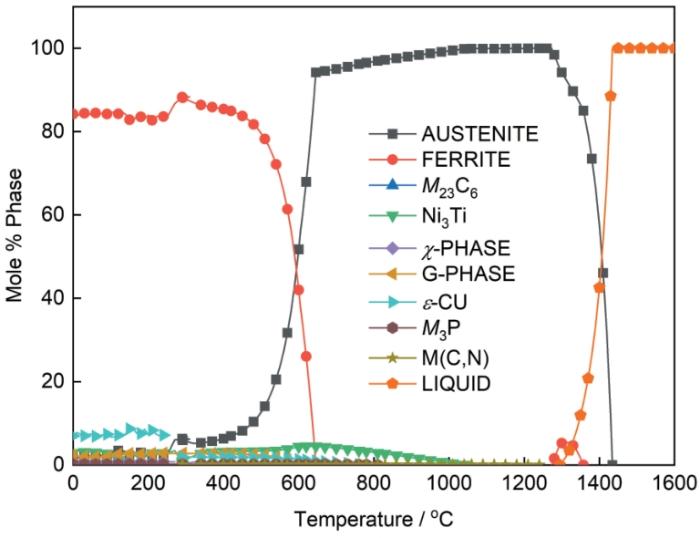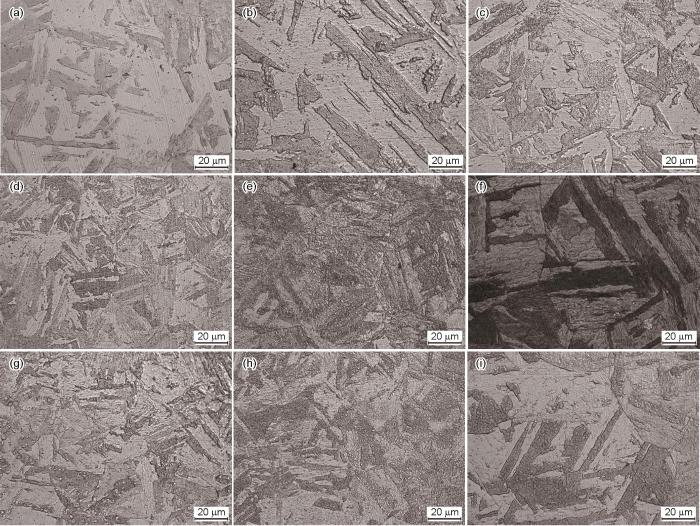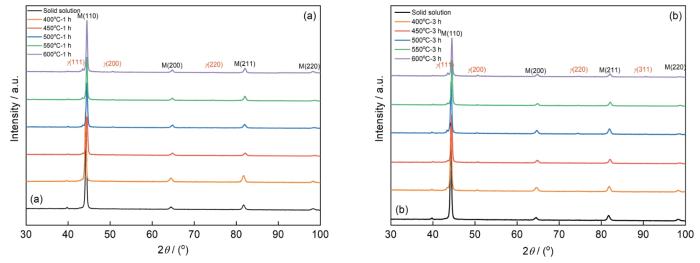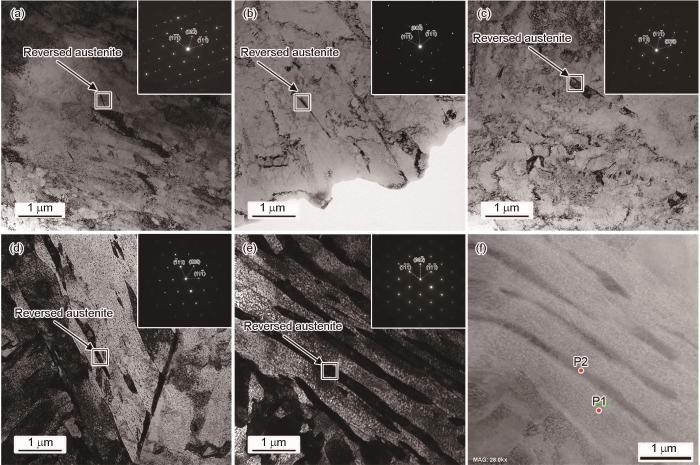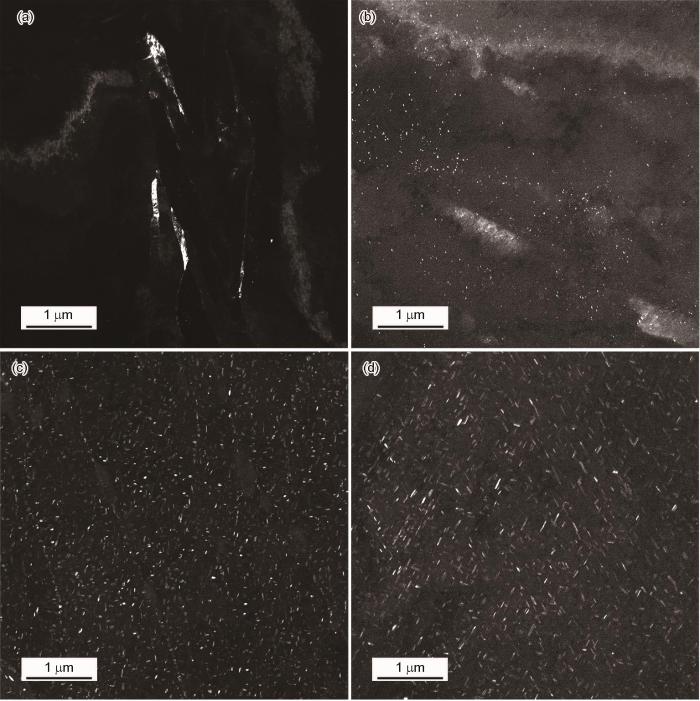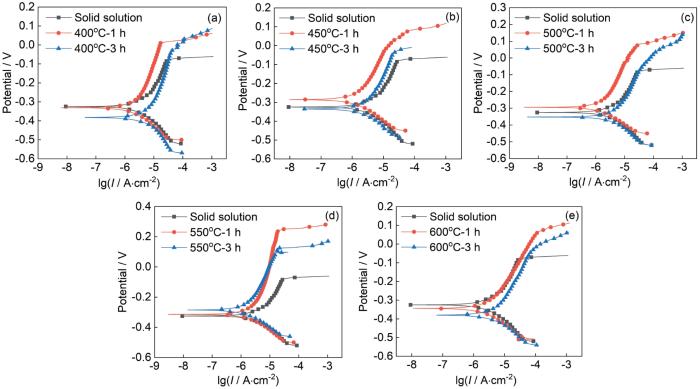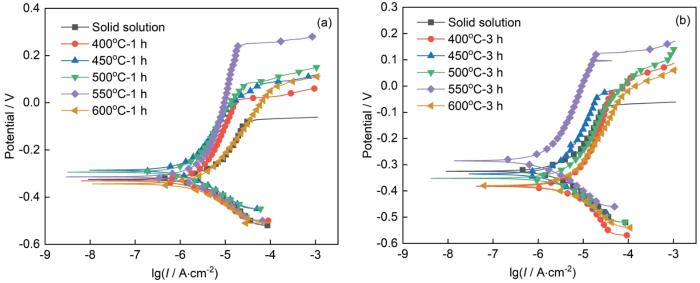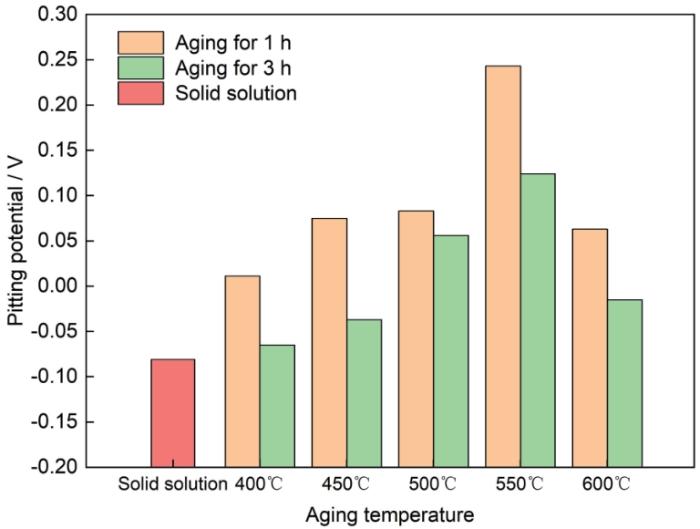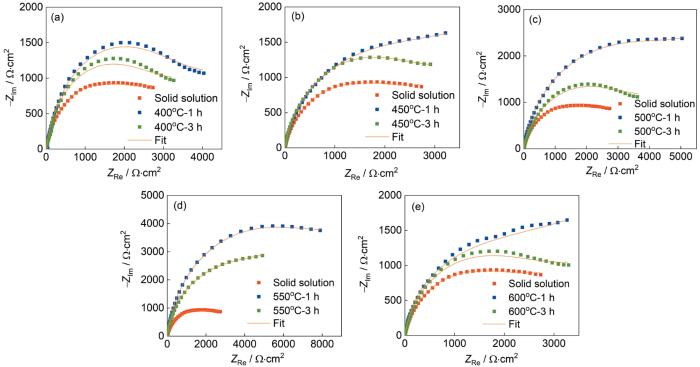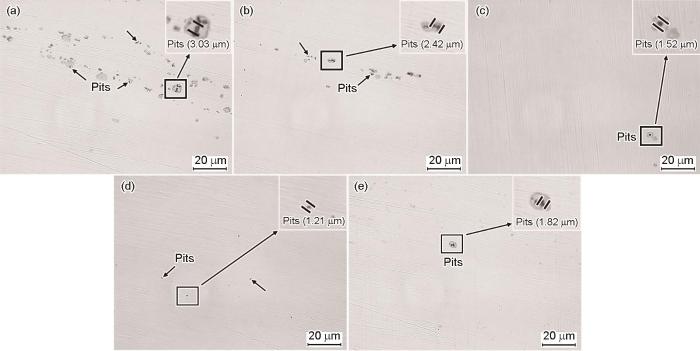马氏体时效不锈钢因其特殊的成分和组织结构而具有良好的强韧性、耐蚀性、可焊性及冷热加工性,广泛应用于制备航空、航天、海洋、核工业中承受剧烈机械载荷和恶劣腐蚀环境的构件[1,2]。经过六十多年的发展,马氏体时效不锈钢已形成了比较完备的品种系列,其中代表性的牌号有PH13-8Mo、Custom450、Custom455、Custom465等[3]。上世纪70年代,美国Carpenter Technology公司率先研制出含Co的Pyromet X-12马氏体时效不锈钢,之后又开发出不含Co的Custom450、Custom455不锈钢,其中,Custom455不锈钢相比其他类型马氏体时效不锈钢具有强度高、热处理工艺简单、焊接性优良、易加工等特点,其强化机制是低碳马氏体结构与沉淀析出相结合引起的沉淀强化[4,5]。
时效处理是马氏体时效不锈钢制备加工过程中必备的工艺之一,对性能有着至关重要的影响。Afshari等[5]研究了时效温度对PH13-8Mo钢组织和力学性能的影响,结果表明经过500℃时效处理后试样组织均匀性最好,硬度和耐磨性达到最大。李科欣等[6]通过对Co-Cu合金化马氏体时效硬化不锈钢进行时效处理,结果表明试样在480℃时效2 h后的综合力学性能最好。Dennies[7]研究了Custom455马氏体时效硬化不锈钢的氢脆敏感性,结果表明Ni3Ti粒子的析出以及低含碳量会使不锈钢的晶格应变降低,进而降低不锈钢的氢脆敏感性。目前,关于时效处理对马氏体时效不锈钢性能影响的研究工作主要集中在强韧性、疲劳等力学性能方面[7~11],鲜有对抗点蚀性能的影响研究。对于马氏体时效不锈钢而言其抗点蚀性能也同样重要,因此在时效处理与力学性能关系研究的基础上有必要探讨时效处理对抗点蚀性能的影响及机理。本文采用Custom455马氏体时效硬化不锈钢为研究对象,探究时效处理工艺对其抗点蚀性能产生的影响,为热处理制度的优化提供一定的参考。
1 实验方法
实验材料为Custom455马氏体时效硬化不锈钢,主要化学成分(质量分数,%)为:C 0.009,Si 0.34,Mn 0.50,P 0.032,Cr 12.28,Ni 8.27,Cu 2.17,Mo 0.28,Nb 0.29,Ti 1.23。在箱式电阻炉中对试样进行1100℃ × 1.5 h固溶处理,然后对固溶试样进行400~600℃(间隔50℃)时效处理1和3 h,时效处理后水冷至室温。时效温度范围根据JMatePro热力学软件计算的相图(图1)确定。将抛光后的试样放入38%(质量分数)浓盐酸和98%(质量分数)浓硫酸等比例混合溶液中腐蚀10 s,再用徕卡DM4000M型光学金相显微镜观察试样组织。采用Rigaku Ultima IV型X射线衍射仪(XRD)对试样进行物相分析。将试样厚度打磨减薄至80 μm后,用冲孔器冲压得到直径3 mm的圆片,然后利用电解双喷减薄仪在温度-30℃、电压20 V的参数条件下进行减薄,双喷液选择浓度为10%的高氯酸酒精溶液。使用FEI Tecnai G2 F20 场发射透射电镜(TEM)分析试样的微观结构与析出相。
图1
图1
Custom455不锈钢相图计算结果
Fig.1
Calculated phase diagram of Custom455 steel by JMatPro software
采用动电位阳极极化和电化学阻抗谱(EIS)技术进行点蚀研究,测量试样的点蚀电位以评价其抗点蚀性能,实验溶液选用3.5%(质量分数)NaCl溶液,测试温度为30 ± 1℃。电化学测量在CHI电化学工作站(CH Instruments)进行。采用Custom455试样制备暴露面积为1 cm × 1 cm的工作电极。参比电极采用饱和甘汞电极(SCE),辅助电极采用铂箔。测试前,将工作电极在测试溶液中浸泡30 min,直至开路电位(Eocp)达到稳定,然后以20 mV/min的速率从-400 mV (SCE)向阳极方向扫描到合适的值。在开路电位(Eocp)下,EIS测量在105~10-2 Hz的频率范围进行,正弦电位的振幅设为10 mV。
2 结果与分析
2.1 金相及物相组织分析
图2
图2
经不同条件热处理的Custom455钢金相组织
Fig.2
Metallographic structures of Custom455 steel after solid solution (a) and aging (b-i) heat treatments: (b) 400oC/3 h, (c) 450oC/3 h, (d) 500oC/3 h, (e) 550oC/3 h, (f) 600oC/3 h, (g) 500oC/1 h, (h) 550oC/1 h, (i) 600oC/1 h
图3为固溶后未时效和经不同温度和时间时效处理试样的XRD谱。可见,试样经时效后具有马氏体和逆转变奥氏体(2θ = 43.54°)的衍射峰,如图3a和b所示,但未时效的固溶态试样中未出现奥氏体衍射峰。说明经过时效处理后,试样基体主要由马氏体和逆转变奥氏体组成。采用相对强度比(RIR)法[13,14]计算逆转变奥氏体含量,结果如图4所示。随着时效温度和时间的增加,逆转变奥氏体含量从约1.5%增加到14.3% (体积分数)。根据试样的热力学相图(图1)可知,高于300℃时,试样中的马氏体将开始转变成奥氏体,并且随着温度的升高,奥氏体的含量不断增加;这是因为温度越高,马氏体的热力学稳定性越差,Ni原子的扩散能力越强。随着时效温度升高和时间延长,Ni在逆变奥氏体内不断富集,导致逆变奥氏体尺寸逐渐长大[12,15]。
图3
图3
经不同温度时效处理的Custom455钢的XRD谱
Fig.3
XRD patterns of Custom455 steel after aging at different temperatures for 1 h (a) and 3 h (b)
图4
图4
经不同温度时效处理的Custom455钢中逆转变奥氏体含量
Fig.4
Statistical values of the contents of reversed austenite in Custom455 steel aged at different temperatures
2.2 透射电镜结果分析
图5
图5
不同参数时效处理后Custom455钢的TEM像
Fig.5
TEM images of Custom455 steel after aging treatments with different parameters: (a) 400oC/3 h, (b) 500oC/1 h, (c) 500oC/3 h, (d) 600oC/1 h, (e, f) 600oC/3 h
表1 经600℃/3 h时效处理试样不同位置(见图5f中标记点)EDS分析结果 (mass fraction / %)
Table 1
| Position | Ti | Cr | Ni | Mo | Mn | Fe |
|---|---|---|---|---|---|---|
| P-1 | 0.21 | 13.72 | 6.50 | 0.22 | 0.53 | 78.64 |
| P-2 | 2.21 | 10.68 | 13.72 | 0.34 | 0.32 | 64.44 |
此外,当试样经过500℃/3 h时效处理后,试样中开始有明显的Ni3Ti以及富Cu相ε-Cu析出(图6和7),主要呈圆形及棒状,且随着时效时间的延长和时效温度的升高,析出相数量变多,尺寸越大[16],Ni3Ti尺寸由60 nm增长到500 nm,富Cu相颗粒大小由5 nm增长到20 nm。Sun等[17]通过TEM和三维原子探针(3D APT)显微技术研究观察表明,Custom455不锈钢经850℃淬火和480℃时效4 h后,钢中含有大量密集分布在马氏体基体中的纳米级、球状富Cu析出相和一些与富Cu析出相相邻的棒状Ni3Ti析出相。Stiller等[18]研究表明Custom455不锈钢经过475℃时效后有富Cu相和富Ni相析出,且析出相的尺寸和数量随着时效时间的延长而增加。Sha[19]利用Thermo-Calc软件计算了Custom455不锈钢的热力学平衡,得出时效温度475℃时,基体中会析出富Cu相和Ni3Ti相。Andersson等[20]采用三维原子探针(3D APT)和TEM研究了Custom 455在时效过程中的析出行为,结果表明试样在475℃下、老化25 min后观察到富Ni、Ti和Cu混合相的析出。随老化时间延长,观察到η-Ni3Ti沉淀析出。在老化2 h后,在板条边界处观察到大体积、富含Ni/Ti和Cu的析出相。
图6
图6
不同时效处理后试样的TEM像
Fig. 6
TEM images of Custom455 steel aged at 500oC (a, b) and 600oC (c, d) for 1 h (a, c) and 3 h (b, d), respectively
图7
图7
经500℃/3 h时效处理后试样的析出相
Fig.7
Precipitation phases of Custom455 steel after aging at 500oC for 3 h: (a) Ni3Ti, (b, c) ε-Cu
2.3 电化学实验结果分析
2.3.1 极化曲线测试结果
图8和9显示了固溶和时效处理试样的极化曲线测试结果。图10为试样点蚀电位的变化对比图。由图8和9可知,当时效时间为1或3 h时,试样的耐点蚀性能随着时效温度的升高呈现出先增大后减小的趋势,时效温度为550℃时试样耐点蚀性能最好,而时效温度达到600℃时点蚀电位下降;不同时效温度下,随着时效时间的延长试样耐点蚀性能下降。相比固溶态试样,经过1 h时效处理的试样点蚀电位增大,耐点蚀性能上升,这是由于马氏体时效硬化不锈钢经时效后有逆转变奥氏体形成。逆转变奥氏体的形成减少了点蚀形核位点的数量;其次逆转变奥氏体总是沿马氏体板条边界分布,这阻止了点蚀传播,提高了耐点蚀性能[21~24]。3 h时效处理时,虽然随着温度的升高逆转变奥氏体的含量增多,对耐蚀性有利,但一方面,整体上逆变奥氏体含量比1 h时效时增加的不明显;另一方面,此时效时间内,试样中析出的第二相粒子数量也比1 h时效时多、尺寸比1 h时效时大。Ni3Ti以及ε-Cu相是不锈钢中的主要析出相,ε-Cu的电极电位较高,而基体的电极电位低,存在电位差,两者会形成电化学微电池,诱发点蚀形成[25];另一方面,ε-Cu相是FCC结构,Ni3Ti是HCP结构,马氏体基体是BCC结构,由于不锈钢中析出的第二相粒子与基体是非共格界面,两者存在较高的界面能,也容易诱发点蚀形成[17]。合金中尺寸大的析出粒子往往是点蚀形核的优先位置,降低耐点蚀性能[26,27]。因此,3 h时效试样的点蚀电位整体上低于1 h时效试样。400~600℃时效时虽然试样中逆变奥氏体含量一直增多(图5),但是600℃时效时试样中析出相数量增多以及尺寸增大(图6),恶化点蚀性能。因此,600℃时效试样的耐点蚀电位低于550℃时效试样。
图8
图8
不同温度时效处理1和3 h试样的极化曲线
Fig.8
Polarization curves of Custom455 steel aged for 1 and 3 h at 400oC (a), 450oC (b), 500oC (c), 550oC (d) and 600oC (e)
图9
图9
不同温度时效处理后试样的极化曲线
Fig.9
Polarization curves of Custom455 steel after aging treatments at different temperatures for 1 h (a) and 3 h (b)
图10
图10
不同温度时效处理1和3 h试样点蚀电位的变化
Fig.10
Pitting potentials of Custom455 steel aged at different temperatures for 1 and 3 h
2.3.2 电化学阻抗测试结果
EIS实验等效电路如图11所示,图中Rs代表溶液的电阻,CPE1代表常相位角元件,Rp代表阻抗值,然后用Zview Version 3.1软件拟合实验曲线,得到等效电路中元件的特征参数值。EIS结果如图12~14所示。结果显示,固溶和时效处理试样的Nyquist图均为圆弧且都有钝化区,这表明所有试样均能形成致密的钝化膜,具有良好的耐蚀性,不同样品的Nyquist图在阻抗谱中可以观察到明显的差异(图12)。通常圆弧半径的增加用Rp值的增加来表示,Rp值的增加与体系的腐蚀速率成反比。阻抗图的拟合参数如表2和3所示。由此可知,试样经过1 h时效后,Rp值普遍增大,这表明试样经过时效处理后抗点蚀性能提高。这是由于马氏体时效硬化不锈钢经过时效处理后会有逆转变奥氏体形成,其与马氏体板条基体相比,逆转变奥氏体具有较高的Ni和Mo含量,而Cr含量相近,逆转变奥氏体的存在可以降低Cr的损耗程度,增强钝化膜的稳定性,从而提高试样的抗点蚀性能[21~24]。此外,经过3 h时效的试样比1 h的Rp值更小,表明随着时效时间增加试样抗点蚀性能下降。当时效温度升至500℃时,随着时效温度和时间的增加,Ni3Ti和ε-Cu等析出相的数量和尺寸会增加,这些第二相粒子容易成为点蚀形核位点,进一步破坏钝化膜表面的稳定性,从而降低试样的抗点蚀性能[26,27]。
图11
图12
图12
试样经过不同温度时效处理后的Nyquist图
Fig.12
Nyquist plots of Custom455 steel after aging treatments for 1 and 3 h at 400oC (a), 450oC (b), 500oC (c), 550oC (d) and 600oC (e)
图13
图13
经不同温度时效处理1和3 h试样的Nyquist图
Fig.13
Nyquist plots of Custom455 steel after aging treatments at different temperatures for 1 h (a) and 3 h (b)
图14
图14
经不同温度时效处理1和3 h试样的Bode图
Fig.14
Bode plots of Custom455 steel after aging treatments at different temperatures for 1 h (a) and 3 h (b)
表2 Custom455不锈钢时效处理1 h在3.5%NaCl溶液中的EIS拟合参数值
Table 2
| Specimen | Rs / Ω·cm2 | CPE-T / F·cm-2·s n | CPE-n | Rp / Ω·cm2 |
|---|---|---|---|---|
| Solid solution | 2.623 | 1.5493 × 10-4 | 0.81756 | 3165 |
| 400oC-1 h | 2.045 | 1.0443 × 10-4 | 0.83613 | 4278 |
| 450oC-1 h | 2.484 | 9.018 × 10-5 | 0.82998 | 5357 |
| 500oC-1 h | 2.892 | 7.4562 × 10-5 | 0.84689 | 7622 |
| 550oC-1 h | 2.79 | 6.2188 × 10-5 | 0.88235 | 11443 |
| 600oC-1 h | 3.272 | 1.0213 × 10-4 | 0.82942 | 5131 |
表3 Custom455不锈钢时效处理3 h在3.5%NaCl溶液中的EIS拟合参数值
Table 3
| Specimen | Rs / Ω·cm2 | CPE-T / F·cm-2·s n | CPE-n | Rp / Ω·cm2 |
|---|---|---|---|---|
| Solid solution | 2.623 | 1.5493 × 10-4 | 0.81756 | 3165 |
| 400oC-3 h | 4.917 | 1.227 × 10-4 | 0.84227 | 3707 |
| 450oC-3 h | 2.322 | 9.2448 × 10-5 | 0.84043 | 4261 |
| 500oC-3 h | 2.917 | 8.1282 × 10-5 | 0.80768 | 4304 |
| 550oC-3 h | 2.888 | 7.2198 × 10-5 | 0.85967 | 9138 |
| 600oC-3 h | 3.207 | 9.8621 × 10-5 | 0.84144 | 3690 |
图13为相同时效时间、不同温度的试样Nyquist图。由图可知,时效时间相同时,试样的Rp值随着时效温度的上升先增大后减小。表2和3显示,试样经过550℃时效处理的Rp值较高,但时效温度升至600℃时Rp值降低,这表明钝化膜的致密性和保护性能随着时效温度的上升先增强后减弱,这与所研究试样的点蚀电位结果是一致的。且CPE-T值越低,电极表面形成的钝化膜越多,表明钝化膜稳定性越好,这与前文的研究结果相符。图14为相同时效时间、不同温度的试样Bode图,通常根据低频区(0.01 Hz)的阻抗值及相位角的大小判断试样的抗点蚀性能,低频区的阻抗值及相位角越大,试样的抗点蚀性能就越好。由图可知,时效时间相同时,试样的耐蚀性能随着时效温度的上升先增强后下降,这进一步验证了实验结果。
2.3.3 电化学测试后的组织形貌
图15是试样经过电化学极化曲线测试后的组织形貌图。由图可知,固溶态试样的点蚀坑尺寸为3.03 μm左右,试样经过时效处理(400℃-3 h)后有逆转变奥氏体形成,试样的耐点蚀性能提高,因此点蚀坑的数量减少,点蚀坑尺寸减小至2.42 μm。随着时效温度上升,基体中逆转变奥氏体的含量也不断增加,所以点蚀坑的数量进一步减少,尺寸也逐渐减小。其中,当时效温度为600℃时,随着时效时间由1 h延长至3 h,由于Ni3Ti及ε-Cu粒子大量析出且尺寸变大,试样耐点蚀性能下降,点蚀坑的大小从1.21 μm增至1.82 μm。
图15
图15
试样的点蚀形貌
Fig.15
Pitting morphologies of Custom455 steel after solid solution (a) and aging treatments at 400oC for 3 h (b), 500oC for 3 h (c), 600oC for 1 h (d) and 600oC for 3 h (e)
3 结论
(1) 试样在时效过程中会有富铜相、Ni3Ti等第二相粒子析出,且随着时效温度和时间的增加,第二相粒子的数量和尺寸也会逐渐增加。基体中的第二相粒子是点蚀发生的敏感位置,容易诱发点蚀。
(2) 固溶态的试样经过时效处理后会有逆转变奥氏体形成,试样中的逆转变奥氏体含量随着时效温度、时间增加而增多。Ni作为奥氏体稳定元素,在逆转变奥氏体中的含量高,其可以提高不锈钢的钝化能力与点蚀电位,增强不锈钢的耐点蚀性能。
(3) 当时效时间一定、时效温度为400~550℃时,随着时效温度的上升,逆转变奥氏体的含量逐渐上升,且析出相尺寸、数量较少,所以试样的抗点蚀性能逐渐上升;但时效温度达到600℃时,试样中有大量的富铜相和Ni3Ti析出,导致试样耐点蚀性能下降。随着时效温度和时间增加,试样中析出相的数量增多,富铜相颗粒尺寸由10 nm增长到80 nm,Ni3Ti尺寸由60 nm增长到500 nm,逆转变奥氏体含量升高引起的不锈钢点蚀性能提高作用不足以抵消析出相对点蚀性能的恶化作用,试样抗点蚀性能下降。
参考文献
Alloying design, microstructures and properties of martensitic ageing stainless steel
[M].
Research development of precipitation behavior of ultra high strength stainless steels
[J].
超高强度不锈钢沉淀行为研究进展
[J].
Development of maraging stainless steel
[J].
马氏体时效不锈钢的发展
[J].
Effect of structure transformation in a ultra-high strength maraging stainless steel on its mechanical properties
[J].
一种超高强度马氏体时效不锈钢的组织转变对力学性能的影响
[J].
Effect of heat treatment on microstructure and tribological performance of PH 13-8Mo stainless steel fabricated via wire arc additive manufacturing
[J].
Effect of aging temperature on microstructure and properties of Co-Cu alloying maraging hardening stainless steel
[J].
时效温度对Co-Cu合金化马氏体时效硬化不锈钢组织性能的影响
[J].
Proposed theory for the hydrogen embrittlement resistance of martensitic precipitation age-hardening stainless steels such as custom 455
[J].
Effect of Co on microstructure and properties of maraging stainless steel
[J].
Co对马氏体时效硬化不锈钢组织和性能的影响
[J].
Influence of hot forging and alloying with Al on the electrochemical behavior and mechanical properties of austenitic stainless steel
[J].
Microstructure and properties of martensite age-hardening stainless steel with vacuum heat treatment
[J].
马氏体时效硬化不锈钢真空热处理的组织和性能
[J].
Study on electrochemical properties of Co-containing martensitic age-hardened stainless steels
[D].
含钴马氏体时效硬化不锈钢的电化学性能研究
[D].
Growth behavior and precipitation of reverted austenite in ultra-high strength marageing stainless steel
[J].
超高强度马氏体时效不锈钢中逆转变奥氏体的析出与长大行为
[J].
Effect of Cr content on the passivation behavior of Cr alloy steel in a CO2 aqueous environment containing silty sand
[J].
Atmospheric corrosion behavior and mechanism of a Ni-Advanced weathering steel in simulated tropical marine environment
[J].
Research on microstructures and properties in super martensitic stainless steel and formation mechanism of reversed austenite
[D].
超级马氏体不锈钢组织性能及逆变奥氏体机制的研究
[D].
Effect of aging treatment on microstructure and mechanical properties of a ultra-high strength maraging stainless steel
[J].
时效对超高强马氏体时效不锈钢组织与性能的影响
[J].
Characterization of nano-precipitates in Custom 455 stainless steel by transmission electron microscopy and atom probe tomography
[J].
Precipitation in 9Ni-12Cr-2Cu maraging steels
[J].
Thermodynamic calculations for precipitation in maraging steels
[J].
Comparison of early stages of precipitation in Mo-rich and Mo-poor maraging stainless steels
[J].
Impact of reversed austenite on the pitting corrosion behavior of super 13Cr martensitic stainless steel
[J].
Prominent role of reversed austenite on corrosion property of super 13Cr martensitic stainless steel
[J].
Assessment of the correlation between M23C6 precipitates and pitting corrosion resistance of 0Cr13 martensitic stainless steel
[J].
Beneficial effect of reversed austenite on the intergranular corrosion resistance of martensitic stainless steel
[J].
Precipitation characterization of NiAl and Cu-rich phases in dual-phase region of precipitation strengthening steel
[J].Precipitation strengthening plays an important role on improving the mechanical properties of steels, NiAl and Cu-rich phases are two kinds of common precipitates. This work aims to reveal the precipitation characteristics of these two phases in martensite and retained austenite in precipitation strengthening steel by atom probe tomography (APT). The hot rolled samples were aged at 500 ℃ for 1 h after solution treatment at 900 ℃ for 2 h, followed by microstructure analysis. The results show that NiAl and Cu-rich phases form in martensite phase as well as at martensite/austenite phase boundaries, while no precipitate develops in retained austenite. Precipitation was not observed near the phase boundaries in martensite. Equivalent radius, spacing and concentration of the strengthening phases at phase boundary are larger than that inside martensite. In addition, NiAl phase tend to separate from Cu-rich phase, and the separated tendency becomes stronger at phase boundaries than in martensite. Besides, the growth of NiAl and Cu-rich phases at phase boundary differs from that within martensite, which should be induced by the defect density difference between them.
沉淀强化钢中两相区NiAl相和富Cu相的析出特点
[J].沉淀强化钢在900 ℃固溶2 h后水淬, 500 ℃时效1 h, 利用原子探针层析技术(APT)研究了残余奥氏体和马氏体两相区强化相的析出特点. 结果表明, 残余奥氏体中没有析出相, 马氏体和马氏体/残余奥氏体界面处均有强化相析出, 马氏体中靠近界面处有一层析出贫化区. 界面处强化相的等效半径和间距均大于马氏体中的强化相, 界面处富Cu相和NiAl相中Cu, Ni和Al的含量均大于马氏体中的富Cu相和NiAl相, 而且界面处富Cu相和NiAl相的分离趋势要大于马氏体, 这是因为界面处存在大量缺陷, 促进了强化相的长大, 使得界面处和马氏体中的强化相处于长大的不同阶段.
Tuning the pitting performance of a Cr-13 type martensitic stainless steel by tempering time
[J].
Effect of heat treatment on microstructure and mechanical properties of Fe-12Cr martensitic steel
[J].
热处理工艺对Fe-12Cr马氏体钢组织与力学性能的影响
[J].对Fe-12Cr马氏体钢包壳管材分别进行980~1050℃下保温15~30 min正火处理,随后在730~790℃温度下进行2 h回火处理,研究不同热处理工艺对Fe-12Cr马氏体钢包壳管材微观组织、室温和高温力学性能的影响。结果表明:正火处理后,冷轧Fe-12Cr马氏体钢的组织为板条马氏体,冷轧态的碳化物粒子会部分固溶于马氏体基体中;随正火温度的升高,残余碳化物的含量降低,且原奥氏体晶粒尺寸会增大(从980℃的9 μm增至1050℃的12 μm);回火处理后,马氏体基体上重新析出细小碳化物粒子,且随回火温度增加,碳化物粒子会发生粗化,平均尺寸为0.2~0.28 μm,而马氏体板条间距几乎不随回火温度发生变化。Fe-12Cr马氏体钢经过1050℃×15 min正火+760℃×2 h回火处理后具有最佳的综合力学性能,其在600℃下的屈服强度为270 MPa,伸长率为40%;此时合金的碳化物粒子体积百分数最高,约为4.5%。




